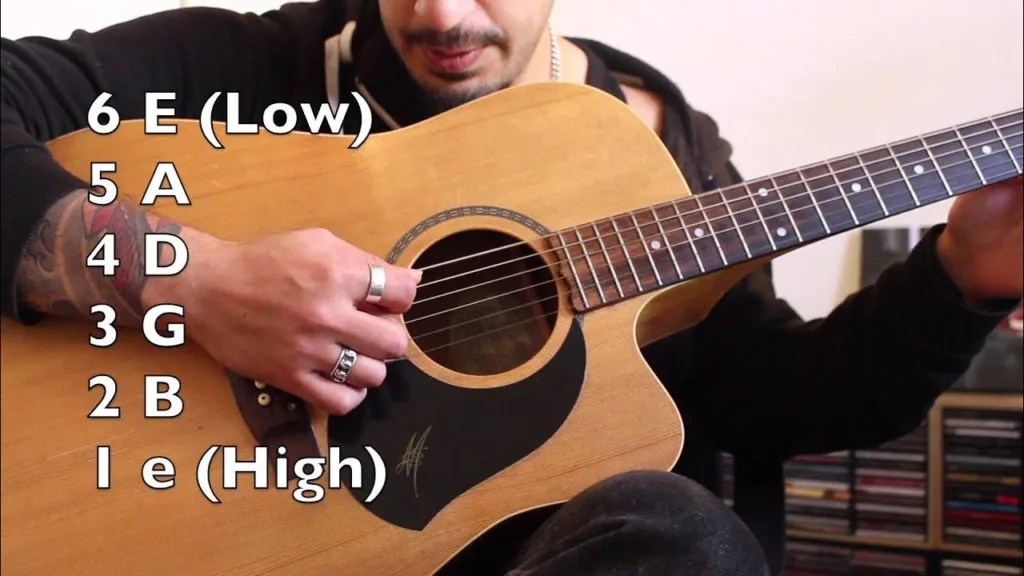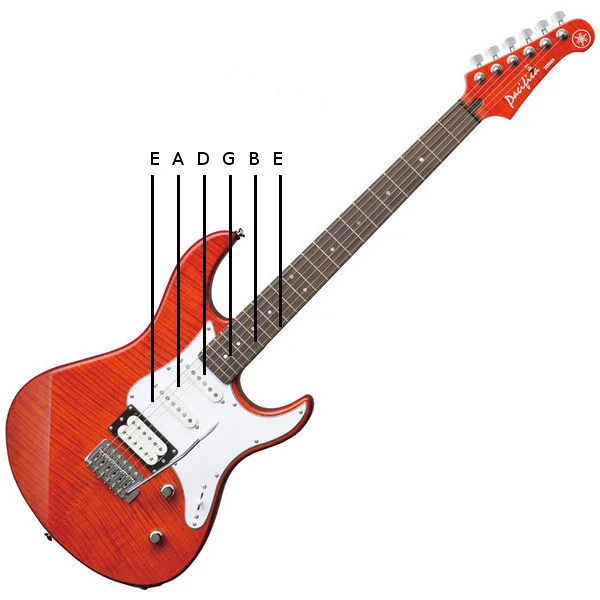Unlocking the Mystery of Guitar String Names: A Beginner’s Guide to Understanding the Basics
Are you a beginner guitarist struggling to remember the names of each string on your instrument? You’re not alone! As someone who has been playing guitar for years, I remember feeling overwhelmed and confused by all those letters and numbers. But fear not, because in this article we’ll demystify the guitar string names together.
We’ll start with the basics – what are the actual names of each string and how do they correspond to music notation? Then, we’ll dive deeper into understanding why these strings have specific names and how they affect your playing. By the end of this article, you’ll feel confident in identifying each string by name and know their purpose in creating beautiful music. So grab your guitar and let’s get started!
So, what are the guitar string names?
The guitar is a popular and versatile instrument that has been used in various genres of music for centuries. Whether you’re just starting to learn how to play or have been playing for years, understanding the basics of guitar string names is essential.
First and foremost, let’s start with the most basic question: How many strings does a guitar have? The answer may vary depending on the type of guitar, but typically an acoustic or electric guitar has six strings. These strings are numbered from thickest to thinnest, with the thickest string being number 6 and the thinnest being number 1.
Now that we know how many strings there are, it’s important to understand their individual names. Each string has its own specific name based on its thickness and pitch. Starting from the top (thickest) string and moving down towards the bottom (thinnest) string, they are named E-A-D-G-B-E.
But what do these letters stand for? They represent each string’s tuning note when played open (without pressing down any frets). The first E stands for “E” note, followed by A for “A” note, D for “D” note, G for “G” note, B for “B” note and finally E again for another high-pitched “E” note.
It may seem overwhelming at first trying to remember all these different names and notes, but with practice it will become second nature. It’s also helpful to remember that each letter corresponds with a certain finger placement on your left hand while playing chords or melodies.
Additionally, knowing these string names can come in handy when reading sheet music or tabs as they often refer to specific strings by name rather than number. It also allows you to communicate more effectively with other musicians during jam sessions or performances.
So whether you’re strumming along to your favorite songs or composing your own melodies on the guitar, understanding the basics of string names is crucial. With time and practice, you’ll become more familiar with each string and its unique sound, allowing you to create beautiful music on this timeless instrument.
Understanding the Basics: What are the Names of Each Guitar String?
When you pick up a guitar, the first thing you notice is its six strings, each with its own unique name and purpose. The strings are usually numbered from the bottom to the top when you’re holding the guitar. Starting with the string closest to your body, we have the thickest string known as E, also referred to as the sixth string. Next comes A (the fifth string), followed by D(fourth), then G (third). As you move higher in pitch, you’ll find B on your second string and finally—at the very top—the high-pitched E, which is known as the first string.
Understanding these names helps beginners learn to play chords and tunes more easily. It’s like knowing a little secret code for music! Each letter represents not just a sound but various emotions that can be expressed through different notes. You might start strumming simple songs or tuning your guitar properly using this knowledge. Imagine playing your favorite tune:
– Strumming an A chord feels warm and inviting.
– Moving to D might evoke feelings of nostalgia.
All these connections make learning even more exciting as you embark on this musical journey!

Read also: yamaha classic guitar
Exploring Musical Notation: How Guitar Strings Correspond to Notes
When you pick up a guitar, it’s like stepping into a world where music comes alive through strings and frets. Each of the six strings on the guitar represents a specific note when strummed open. Starting from the thickest string to the thinnest, these notes are E, A, D, G, B, and E again. Imagine holding this instrument; as your fingers press down on various frets along the neck of the guitar, you’re not just creating sounds but also transforming those simple notes into chords that can convey emotions. The beauty lies in how every fret raises the pitch by one half-step! This means if you press down on the first fret of the low E string (the sixth string), it becomes an F note.
Musical notation adds another layer to this creativity. Think of it as a secret language between musicians. When you look at sheet music or tablature for guitars specifically designed for beginners, it’s often displayed in such a way that highlights exactly where to place your fingers without needing extensive musical training.
With practice and familiarity with these symbols—like quarter notes or rests—you’ll be able to read melodies effortlessly while understanding how they relate back to those keynotes you’ve been playing all along! Embracing musical notation opens doors not only for individual expression but also fosters connections with other musicians who speak this universal language too.
Why Do Guitar Strings Have Specific Names? Decoding The Reasoning
When you pick up a guitar, the six strings are usually referred to by specific names: E, A, D, G, B, and e. Each name corresponds to a musical note that helps musicians communicate more easily. This naming system is rooted in music theory and history. The lowest string is called the low E because it produces an E note when played open. As you move up the strings towards your face, they ascend in pitch: A follows E, then D comes next. It’s like climbing a staircase of sound! Understanding these names allows players to comprehend chord shapes and scales quickly while connecting with others who play.
Moreover, having named strings simplifies learning for beginners and enhances communication among musicians. For example, if someone says they’re playing an A major chord or using the G string for a solo riff, other players instantly understand what that means without needing additional explanation. These labels create clarity in both practice sessions and performances. Furthermore, many songs are based on these standard tuning notes which form the foundation of countless genres—from rock to classical—allowing for seamless collaboration across different styles of music.
Ultimately, this structured naming system not only streamlines education but also enriches the experience of creating beautiful melodies together.
The Impact on Your Playing: How Understanding Guitar String Names Improves Performance
When you dive into the world of guitar playing, knowing the names and types of strings can truly elevate your performance. Each string has its unique role in creating that beautiful melody or riff. For instance, the low E string provides a deep foundation, while the high E string adds brightness and sparkle to your chords. By understanding these distinctions, you can choose which strings to emphasize during a song. This knowledge helps you experiment with different techniques like fingerpicking or strumming patterns that suit each string’s characteristic sound.
Moreover, recognizing how various materials affect tone is crucial for shaping your music style. Different strings are made from materials such as nickel, stainless steel, or bronze; each offering a distinct tonal quality. Experimenting with these options allows you to find what resonates with your personal taste. Imagine plucking those shiny new strings and hearing their rich tones come alive under your fingers! Furthermore, awareness of string tension enables better control over bends and vibrato techniques—key elements for expressing emotion in your playing. Embracing this understanding not only enhances musical skills but also deepens appreciation for the instrument itself.
With every practice session, you’ll discover how mastering these details transforms ordinary tunes into extraordinary performances.
You may also like: Does Taylor Swift play her own guitar
Conclusion: Mastering the Guitar Basics and Unlocking Musical Potential
Learning the basics of guitar is like opening a door to an exciting new world filled with creativity and expression. Imagine sitting on your porch, strumming simple chords on a warm summer evening while friends gather around, singing along. The joy of making music with just six strings is truly magical. Starting with essentials such as tuning the guitar, understanding chord shapes, and practicing finger placement can make this journey enjoyable and rewarding. Each time you pick up the instrument, you’ll feel that sense of accomplishment grow as your fingers dance across the frets.
As you dive deeper into learning scales and rhythms, it’s important to practice regularly. Consistency helps build muscle memory while developing skills over time. Try setting achievable goals for yourself—like mastering three new chords each week or playing along with your favorite songs—which keeps everything fun! Additionally, joining a community or finding an online group allows for sharing experiences and tips with fellow learners; it can spark inspiration when the going gets tough. Embracing these challenges transforms every stumble into a stepping stone toward becoming a confident musician who fully unlocks their potential through self-expression and artistry.
Whether jamming solo or collaborating with others, you’ve taken crucial steps toward musical mastery!

